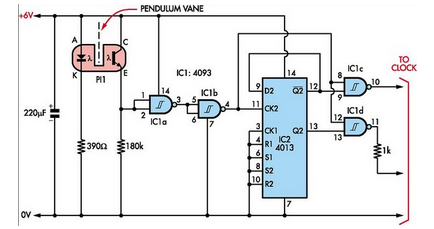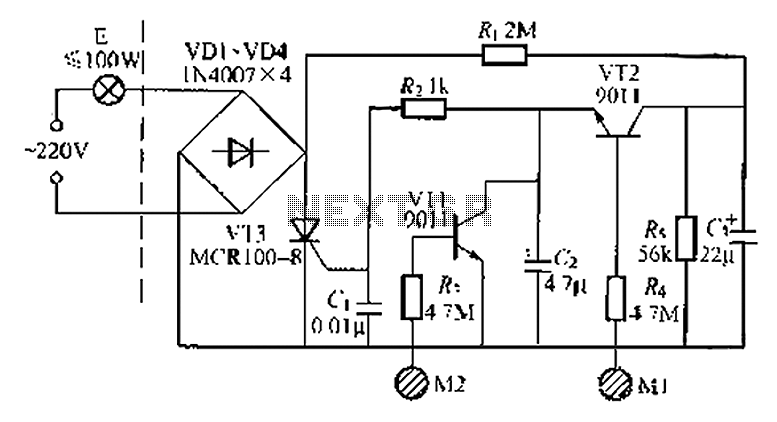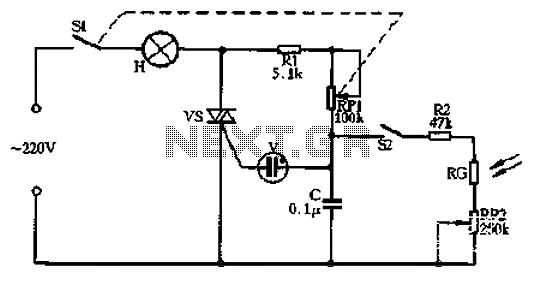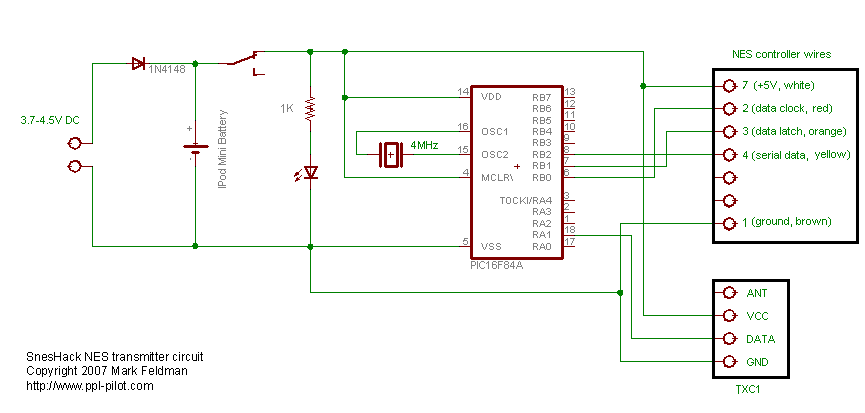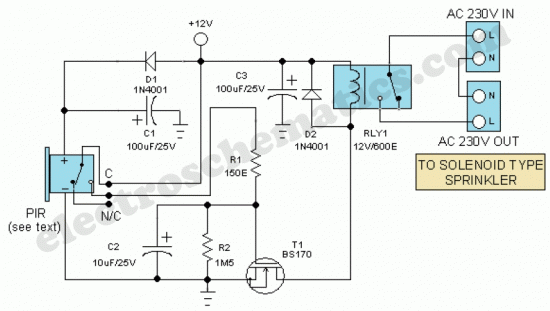
With triac light control lamp 1
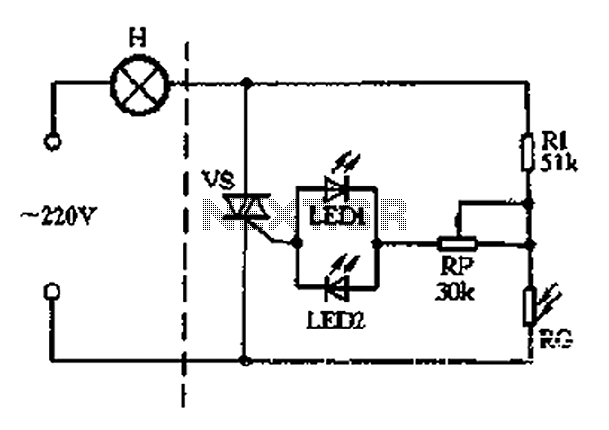
The circuit section includes a photoresistor (RG) and a fixed resistor (Rl) that form a voltage divider. Light-emitting diodes (LED1 and LED2) serve a dual purpose as power indicators and trigger rectifiers. During the positive half-cycle of the alternating current, LED2 illuminates (typically at night) to provide a positive trigger current. Conversely, during the negative half-cycle, LED1 lights up (also at night) to supply a reverse trigger current. During daylight, the strong natural light causes RG to exhibit low resistance, resulting in a low voltage drop, which prevents the lamp (H) from lighting. As night falls, the voltage drop increases, allowing the alternating voltage to trigger LED1 and LED2, which in turn activates the control electrode of the SCR, turning the lamp on. A variable resistor (RP) is included to adjust the sensitivity of the light control.
The described circuit operates as an automatic light control system, utilizing a photoresistor and resistors to regulate the illumination of a lamp based on ambient light conditions. The photoresistor (RG) is sensitive to light levels; during the day, it maintains low resistance, which keeps the voltage across the lamp (H) insufficient for illumination. This ensures energy efficiency by preventing unnecessary lighting during daylight hours.
In low-light conditions, the resistance of RG increases, which raises the voltage across the LED indicators. LED2 is activated during the positive half-cycle of the AC supply, serving as a visual indicator that the circuit is functioning correctly. When the AC supply shifts to the negative half-cycle, LED1 lights up, indicating that the SCR is ready to be triggered. The SCR's control electrode receives the necessary voltage from the LEDs, allowing it to conduct and thus energize the lamp (H).
The inclusion of the variable resistor (RP) enables fine-tuning of the circuit's sensitivity, allowing users to set the threshold at which the lamp will turn on based on the ambient light level. This feature is particularly beneficial in varying environmental conditions, ensuring that the lamp operates optimally according to specific user requirements. The overall design is efficient for applications such as garden lighting, streetlights, or any system where automatic light control is desired based on natural light availability.And the section of the circuit is similar, with the solid photoresistor RG fixed resistor Rl also form a voltage divider. Light-emitting diodes LED1, LED2 here doubles as a pow er indicator, fork for rectifying trigger. When the positive half-cycle alternating current in the positive case of the negative, LED2 is turned on (of course, at night) to vs provide positive trigger current, when the alternating current in the negative at positive negative half-cycle, LED1 is turned on (the same kind should be at night ) to provide reverse trigger current vs. During the day, natural light is strong. RG showed low resistance, low partial pressure, vs can not be opened, the lamp H does not shine. Only nightfall, the partial pressure is higher, the alternating voltage applied to LED1 and LED2 vs SCR control electrode, so vs open, lights on the light H normal light.
RP can be used to adjust the light control sensitivity.
The described circuit operates as an automatic light control system, utilizing a photoresistor and resistors to regulate the illumination of a lamp based on ambient light conditions. The photoresistor (RG) is sensitive to light levels; during the day, it maintains low resistance, which keeps the voltage across the lamp (H) insufficient for illumination. This ensures energy efficiency by preventing unnecessary lighting during daylight hours.
In low-light conditions, the resistance of RG increases, which raises the voltage across the LED indicators. LED2 is activated during the positive half-cycle of the AC supply, serving as a visual indicator that the circuit is functioning correctly. When the AC supply shifts to the negative half-cycle, LED1 lights up, indicating that the SCR is ready to be triggered. The SCR's control electrode receives the necessary voltage from the LEDs, allowing it to conduct and thus energize the lamp (H).
The inclusion of the variable resistor (RP) enables fine-tuning of the circuit's sensitivity, allowing users to set the threshold at which the lamp will turn on based on the ambient light level. This feature is particularly beneficial in varying environmental conditions, ensuring that the lamp operates optimally according to specific user requirements. The overall design is efficient for applications such as garden lighting, streetlights, or any system where automatic light control is desired based on natural light availability.And the section of the circuit is similar, with the solid photoresistor RG fixed resistor Rl also form a voltage divider. Light-emitting diodes LED1, LED2 here doubles as a pow er indicator, fork for rectifying trigger. When the positive half-cycle alternating current in the positive case of the negative, LED2 is turned on (of course, at night) to vs provide positive trigger current, when the alternating current in the negative at positive negative half-cycle, LED1 is turned on (the same kind should be at night ) to provide reverse trigger current vs. During the day, natural light is strong. RG showed low resistance, low partial pressure, vs can not be opened, the lamp H does not shine. Only nightfall, the partial pressure is higher, the alternating voltage applied to LED1 and LED2 vs SCR control electrode, so vs open, lights on the light H normal light.
RP can be used to adjust the light control sensitivity.
